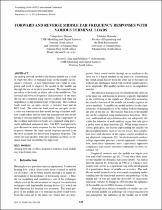JavaScript is disabled for your browser. Some features of this site may not work without it.
- ResearchSpace
- →
- Research Publications/Outputs
- →
- Conference Publications
- →
- View Item
| dc.contributor.author |
Thejane, T

|
|
| dc.contributor.author |
Marwala, T

|
|
| dc.contributor.author |
Smit, Jacoba E

|
|
| dc.contributor.author |
Nelwamondo, Fulufhelo V

|
|
| dc.date.accessioned | 2012-10-25T09:29:26Z | |
| dc.date.available | 2012-10-25T09:29:26Z | |
| dc.date.issued | 2012-09 | |
| dc.identifier.citation | Thejane, T, Marwala, T, Smit, JE and Nelwamondo, FV. Forward and reverse middle ear frequency responses with various terminal loads. International Conference on Modelling and Simulation (IASTED), Gaborone, Botswana, 3-5 September 2012 | en_US |
| dc.identifier.uri | http://hdl.handle.net/10204/6218 | |
| dc.description | International Conference on Modelling and Simulation (IASTED), Gaborone, Botswana, 3-5 September 2012 | en_US |
| dc.description.abstract | An analog network model of the human middle ear is used to study the effect of terminal loads on the middle ear frequency response. A new transformer ratio value is computed and used to improve the model of the middle ear through the use of an ideal transformer. The terminal loads are taken as the loads on either side of the middle ear. The forward and reverse frequency characteristics of the middle ear are computed using various cochlear and outer ear impedances as the terminal load, respectively. The cochlear loads used are an open circuit, a resistive load and an RCL load. The outer ear loads used are an open circuit, a outer ear transmission line model having a constant auditory canal radius and an outer ear transmission line model having a varying auditory canal radius. The components of the cochlear and outer ear loads are computed using previously published anatomical data. The RCL load proved to give the most accurate response for the forward frequency response whereas the open circuit response proved to be the most accurate for the reverse frequency response. The outer ear load models used give minimal accuracy as terminal loads and should thus be improved. | en_US |
| dc.language.iso | en | en_US |
| dc.publisher | ACTA Press | en_US |
| dc.relation.ispartofseries | Workflow;9543 | |
| dc.subject | Analog network | en_US |
| dc.subject | Cochlea | en_US |
| dc.subject | Frequency response | en_US |
| dc.subject | Middle ear | en_US |
| dc.subject | Transformer ratio | en_US |
| dc.subject | Load | en_US |
| dc.title | Forward and reverse middle ear frequency responses with various terminal loads | en_US |
| dc.type | Conference Presentation | en_US |
| dc.identifier.apacitation | Thejane, T., Marwala, T., Smit, J. E., & Nelwamondo, F. V. (2012). Forward and reverse middle ear frequency responses with various terminal loads. ACTA Press. http://hdl.handle.net/10204/6218 | en_ZA |
| dc.identifier.chicagocitation | Thejane, T, T Marwala, Jacoba E Smit, and Fulufhelo V Nelwamondo. "Forward and reverse middle ear frequency responses with various terminal loads." (2012): http://hdl.handle.net/10204/6218 | en_ZA |
| dc.identifier.vancouvercitation | Thejane T, Marwala T, Smit JE, Nelwamondo FV, Forward and reverse middle ear frequency responses with various terminal loads; ACTA Press; 2012. http://hdl.handle.net/10204/6218 . | en_ZA |
| dc.identifier.ris | TY - Conference Presentation AU - Thejane, T AU - Marwala, T AU - Smit, Jacoba E AU - Nelwamondo, Fulufhelo V AB - An analog network model of the human middle ear is used to study the effect of terminal loads on the middle ear frequency response. A new transformer ratio value is computed and used to improve the model of the middle ear through the use of an ideal transformer. The terminal loads are taken as the loads on either side of the middle ear. The forward and reverse frequency characteristics of the middle ear are computed using various cochlear and outer ear impedances as the terminal load, respectively. The cochlear loads used are an open circuit, a resistive load and an RCL load. The outer ear loads used are an open circuit, a outer ear transmission line model having a constant auditory canal radius and an outer ear transmission line model having a varying auditory canal radius. The components of the cochlear and outer ear loads are computed using previously published anatomical data. The RCL load proved to give the most accurate response for the forward frequency response whereas the open circuit response proved to be the most accurate for the reverse frequency response. The outer ear load models used give minimal accuracy as terminal loads and should thus be improved. DA - 2012-09 DB - ResearchSpace DP - CSIR KW - Analog network KW - Cochlea KW - Frequency response KW - Middle ear KW - Transformer ratio KW - Load LK - https://researchspace.csir.co.za PY - 2012 T1 - Forward and reverse middle ear frequency responses with various terminal loads TI - Forward and reverse middle ear frequency responses with various terminal loads UR - http://hdl.handle.net/10204/6218 ER - | en_ZA |






